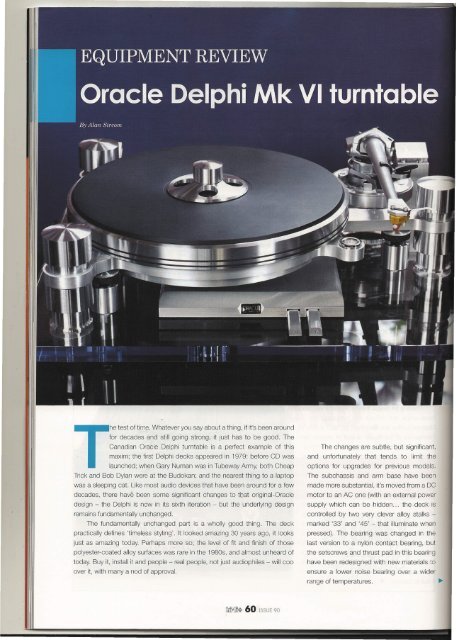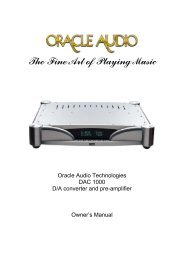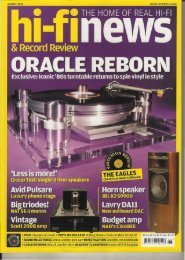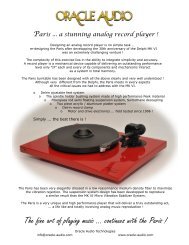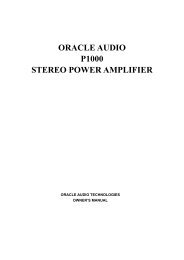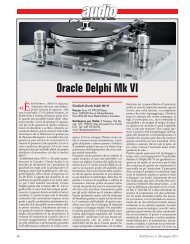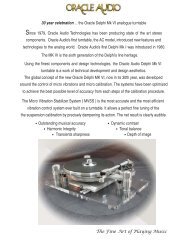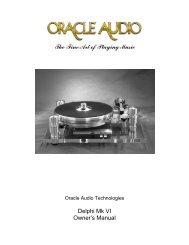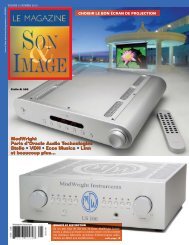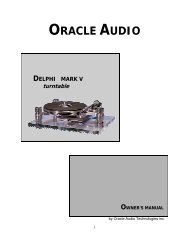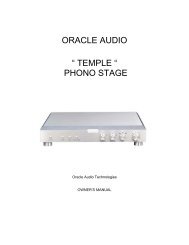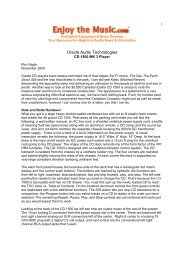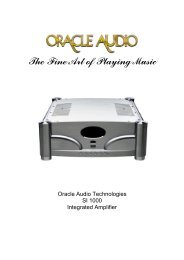[1:fJ{1}o 60 ISSUE 90 - Oracle
[1:fJ{1}o 60 ISSUE 90 - Oracle
[1:fJ{1}o 60 ISSUE 90 - Oracle
You also want an ePaper? Increase the reach of your titles
YUMPU automatically turns print PDFs into web optimized ePapers that Google loves.
The test of time. Whatever you say about a thing, if it's been around<br />
for decades and still going strong, it just has to be good. The<br />
Canadian <strong>Oracle</strong> Delphi turntable is a perfect example of this<br />
maxim; the first Delphi decks appeared in 1979: before CD was<br />
launched; when Gary Numan was in Tubeway Army, both Cheap<br />
Trick and Bob Dylan were at the Budokan; and the nearest thing to a laptop<br />
was a sleeping cat. Like most audio devices that have been around for a few<br />
decades, there have been some significant changes to that original.<strong>Oracle</strong><br />
design - the Delphi is now in its sixth iteration - but the underlying design<br />
remains fundamentally unchanged.<br />
The fundamentally unchanged part is a wholly good thing. The deck<br />
practically defines 'timeless styling'. It looked amazing 30 years ago, it looks<br />
just as amazing today. Perhaps m?re so; the level of fit and finish of those<br />
polyester-coated alloy surfaces was rare in the 1980s, and almost unheard of<br />
today. Buy it, install it and people - real people, not just audiophiles - will coo<br />
over it, with many a nod of approval.<br />
The changes are subtle, but significant,<br />
and unfortunately that tends to limit the<br />
options for upgrades for previous models.<br />
The subchassis and arm base have been<br />
made more substantial, it's moved from a DC<br />
motor to an AC one (with an external power<br />
supply which can be hidden... the deck is<br />
controlled by two very clever alloy stalks -<br />
marked '33' and '45' - that illuminate when<br />
pressed). The bearing was changed in the<br />
last version to a nylon contact bearing, but<br />
the setscrews and thrust pad in this bearing<br />
have been redesigned with new materials to<br />
ensure a lower noise bearing over a wider<br />
range of temperatures. ~<br />
[1:<strong>fJ</strong>{1}o <strong>60</strong> <strong>ISSUE</strong> <strong>90</strong>
EQUIPMENT REVIEW / ORACLE<br />
DELPHI MK VI TURNTABLE<br />
~ But perhaps the really big change is the Micro Vibration Stabilizer System<br />
(MVSS), which are three silicone-filled dashpots sited near the suspension<br />
towers, which damp the free springs in the towers by means of a screw wound<br />
into the silicone. These are adjustable to suit the choice of arm, cartridge,<br />
room size, equipment support, taste, temperature ... practically any parameter<br />
you care to think of. But the result is the same. Perhaps the best way to think<br />
of this is a set of infinitely adjustable shock absorbers on a car; you adjust<br />
them to get the best possible performance, then leave them be, rather than<br />
obsessively<br />
adjust them to suit different needs. I found about two and threequarter<br />
turns on each dash pot worked well (<strong>Oracle</strong> suggests anything from<br />
two to three and a quarter turns of the screw in the goo will do). You find<br />
there's a point where the sound just falls into perfect balance; quarter turn less<br />
and the sound is too soft, a quarter too much and it begins to sharpen up even<br />
legato instruments. The Goldilocks point is easy to identify though.<br />
You've got to admire engineers that decide 'good enough' isn't good<br />
enough, and make their own instead. It engenders and creates an ingenuity<br />
that makes smart solutions for seemingly intractable problems, like the clever<br />
bit of bent wire that makes fitting a belt to a 'difficult'<br />
platter a piece of cake.<br />
That policy extends right down to the optional lid hinges. These are tall,<br />
adjustable blocks of aluminium the size of elegant cigarette lighters (remember,<br />
this harks back to the day when it was still OK to discuss cigarette lighters<br />
without fear of becoming a pariah). The standard hinges wouldn't sustain the<br />
optional folded clear Perspex lid without<br />
having to include less attractive front<br />
supporting uprights, so these custom-built hinges allow the lid to seemingly<br />
float over the turntable.<br />
It's an elegant solution, albeit a more expensive one,<br />
and gives the deck that kind of thoroughbred engineering elegance that is so<br />
rare today.<br />
'Tou've got to admire engineers that decide<br />
'good enough' isn't good enough, and make<br />
their own instead. It engenders and creates<br />
an ingenuity that makes smart solutions for<br />
seemingly intractable problems. "<br />
It's perhaps why - when it comes to tonearms<br />
mutual respect going on between<br />
excellence,<br />
- there is a long-standing<br />
<strong>Oracle</strong> and our own engineering centre of<br />
SME. The default choice of arm for the Delphi VI is an SME, but<br />
uniquely, it's a special '345' version using the armtube<br />
yoke of the SME IV and branded<br />
for the most part. It's a happy balance with the deck.<br />
Although<br />
of the SME V with the<br />
in <strong>Oracle</strong> livery. I used a V with a Lyra Delos<br />
I've had relatively little exposure to <strong>Oracle</strong> decks over the years,<br />
those I've heard have always been good sounding.<br />
a little too good sounding,<br />
Perhaps, it must be said,<br />
straying into 'nice and polite' territory. All of which<br />
makes the Mk VI such a pleasure to play with, because for whatever reason -<br />
OK, it's those three little dash pots - the deck has managed to lose that leadingedge<br />
softening that helped make some of the previous Delphi models sound<br />
a bit 'soft', while retaining that sophisticated<br />
and fundamentally neutral presentation that<br />
always kept you coming back for more.<br />
With the addition of those little dash pots<br />
it seems, the deck now has some pep in its<br />
step. What I find majorly attractive about<br />
the Mk VI is just how easy music flows now.<br />
The Delos is an honest but big cartridge,<br />
which could become 'twitchy' in too free a<br />
system, but sings like dream here. It's tamed<br />
perfectly here though; the richness of the<br />
<strong>Oracle</strong> presentation is no longer 'soft' but<br />
'creamy'. Transients are tight and precise,<br />
but the sound seduces and draws you in.<br />
The presentation is kind of like<br />
listening to Orb records, and the U.FOrb<br />
album did get an airing through this player.<br />
Music is portrayed sumptuously, with a big<br />
soundstage and effortless dynamic range.<br />
Those who love the Well-Tempered sound,<br />
but would like something a bit more 'full-fat'<br />
will love what <strong>Oracle</strong> does to the music. It still ,,~<br />
has the temporal precision and focus of the<br />
likes of W-T, but the <strong>Oracle</strong> adds some meat<br />
to the bones in the process. "<br />
What the <strong>Oracle</strong> brings to the party is<br />
an absence of noise floor. It's a little like your<br />
records have been cleaned that bit deeper,<br />
but I could have sworn my already-quiet Mo-<br />
Fi version of Beck's Sea Change got even<br />
quieter, and those albums that sound like<br />
frying bacon, seemed to let the surface noise<br />
'float' over a quieter underpinning. It sounds<br />
like navel gazing of the first water, but when<br />
you listen to the <strong>Oracle</strong>, you realise there is<br />
a subtle, but important, difference between ~<br />
0i:f}.(Th? 63 <strong>ISSUE</strong> <strong>90</strong>
EQUIPMENT REVIEW / ORACLE<br />
DELPHI MK VI TURNTABLE<br />
~ 'silence' and 'absence of noise'. And, the <strong>Oracle</strong> trades in silence, the rarer<br />
of the two.<br />
OK, let's put the <strong>Oracle</strong> into some perspective. This is a 'spendy' deck;<br />
not in the Kuzma XL4/Continuum field of expenditure, but it's up there with<br />
mid-spec Linn LP12s, Brinkmanns, Clearaudios, SMEs, Avid and VPI models.<br />
And it sits comfortably in among such vaulted company on both sonic and<br />
build-quality standing. It doesn't wipe out the competition, but nor does the<br />
opposition<br />
crush the Canadian deck. You pays your money, and takes your<br />
choice ... and if your choice is a sound that is rich and enveloping<br />
stays just the right side of 'lush', that choice is likely the <strong>Oracle</strong> Delphi VI.<br />
but one<br />
In fact, the manual is the deck's biggest stumbling block now. It reminds<br />
me of a line from a classic slice of 1970s British comedy - "I'm playing all the<br />
right notes, but not necessarily in the right order" - because all the information<br />
needed to get a superb sound from the Delphi VI is in the instruction<br />
manual,<br />
you just need to throw the pages up in the air a few times and hope they end<br />
up reassembling themselves the right way round. Given that an increasing<br />
number of turntables today will be set-up and installed by the end user, the<br />
manual needs a re-shuffle, or even a re-write.<br />
We live in a world of planned obsolescence, of product life cycles<br />
measured in months. A typical computer part might stay on the shelves as<br />
long as a pot of yoghurt these days. Which makes a deck ;-vith staying power<br />
like the <strong>Oracle</strong> all the more exciting. It's been around for decades. It will be<br />
around for decades more. But the changes<br />
made to bring it to Mark VI show<br />
its not simply preserved in aspic. The deck is just as viable in 2012 as it was in<br />
1979 thanks to a series of upgrades and improvements that keep it sounding<br />
as good as it looks. +<br />
TECHNICAL SPECIFICATIONS<br />
Speeds: 33/45rpm (controlled from<br />
stalks on subchassis), fine tune speed<br />
control on separate power supply,<br />
or optional Turbo power supply<br />
Suspension: Tripedal mounting,<br />
each tower featuring seven<br />
mechanical filters<br />
Motor drive electronics and drive belt:<br />
AC synchronous motor, dual current<br />
drive circuitry. Molded belt.<br />
Record / Platter mass: 4kg<br />
Record surface: hard acrylic<br />
Subchassis: brushed aluminum with a<br />
clear lacquer-coat.<br />
Plinth: Clear Acrylic.<br />
An optional Black Granite plinth is<br />
available for an extra charge.<br />
Dimensions (WxDxH): 47.5x36.3x15cm<br />
Weight: 16kg (acrylic base, as tested)<br />
Price (as tested): £8,595-£ 10,895<br />
(excl. tonearm and cartridge)<br />
Manufactured by: <strong>Oracle</strong> Audio<br />
URL:www.oracle-audio.com<br />
Distributed by: Coherent Systems<br />
URL:www.coherent-systems.co.uk<br />
Tel: 0845 5191833 (UK only)<br />
l1:fi{lk? 64 <strong>ISSUE</strong> <strong>90</strong>


